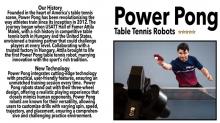Table Tennis Footwork
By Samson Dubina
Over and over and over again...
many table tennis players worldwide struggle to move to the wide forehand. There are dozens of techniques that can be used, but for today, I would recommend that you start practicing these three basic ones.
They say a picture is worth a thousand words. Well, I think a video is worth a million words. So in addition to this short article, I have a video demo for you as well! (Read the article and make sure that you check out the video!)
Type I - Side Shuffle
This is a simple movement typically used when you see where the ball is going. You are in the center of the table and you see your opponent pushing or blocking or looping to your wide forehand, you will use the simple side shuffle. It is the best way to stay balanced, transfer the weight, and recover for the next hit. So how do you do it? Your outside foot (left foot) leaves the ground first, moves toward the right foot, and nearly kicks the right foot to the right. While moving, your racket stays high and in-front. Once you land, your body turns back (which takes your swing back), weight transfers to the right foot, then you begin swinging forward. At the point of contact, the weight is now transferred to the left foot, then you recover for the next shot.
Type II - Side Jump
If you are watching your opponent's racket angle and timing, you will often see where he is hitting. However, there are times that you will be surprised. When surprised, I would recommend using the side-jump. With this technique you move both feet and your hand at the same time. The critical element here is that you land neutral, with your weight balanced on both feet. If you do it correctly, you should be able to transfer 5% or 10% of your weight to the left foot so that you end the stroke with 60% of the weight on the left foot and 40% of the right foot. HUGE PITFALL: Most players are used to taking a big backswing on their forehand with a huge weight transfer. If you do this when surprised, you will lose the balance, lose the positioning, lose the timing, and get pushed off the table. If you land with your weight on both feet, the ball quality will be much better and you will stay balanced and at your preferred distance. A classic drill to practice this is backhand to backhand rally with your training partner, he changes to your forehand, then continues to go backhand to backhand. What do you need to do here? Stay balanced when playing backhands. Be ready to move to the wide forehand. When surprised, activate both feet. Land with both feet and recover.
Type III - Cross-Step
If you often pivot and play with your forehand from the backhand side, then this shot is critically important. Anytime you need to cover a distance of more than 8-10 feet, it is better to use the cross-step than to attempt a side-jump. The benefit is that it is faster and easier to cover a long distance. The down-side is that it is tougher to recover. So how do you do it? Initiate a small step with the right to start your momentum, extend your arm to the right while turning your body and jumping with the left. Your left foot should be landing as your racket is making contact with the ball. Next, your right foot should swing forward and both feet should re-positioning your body for the next hit.
Hi Friends,
We are offering the BEST SALE OF THE YEAR on all 3 Power Pong Robots! Click the link below to find out how you can save $500 on the world's most advanced table tennis robot with FREE Balls and FREE Shipping and also get free online lessons with it as well!
Click HERE for Power Pong Robot Purchase Information
Wide Forehand

Check out the NEW Video
Category:



